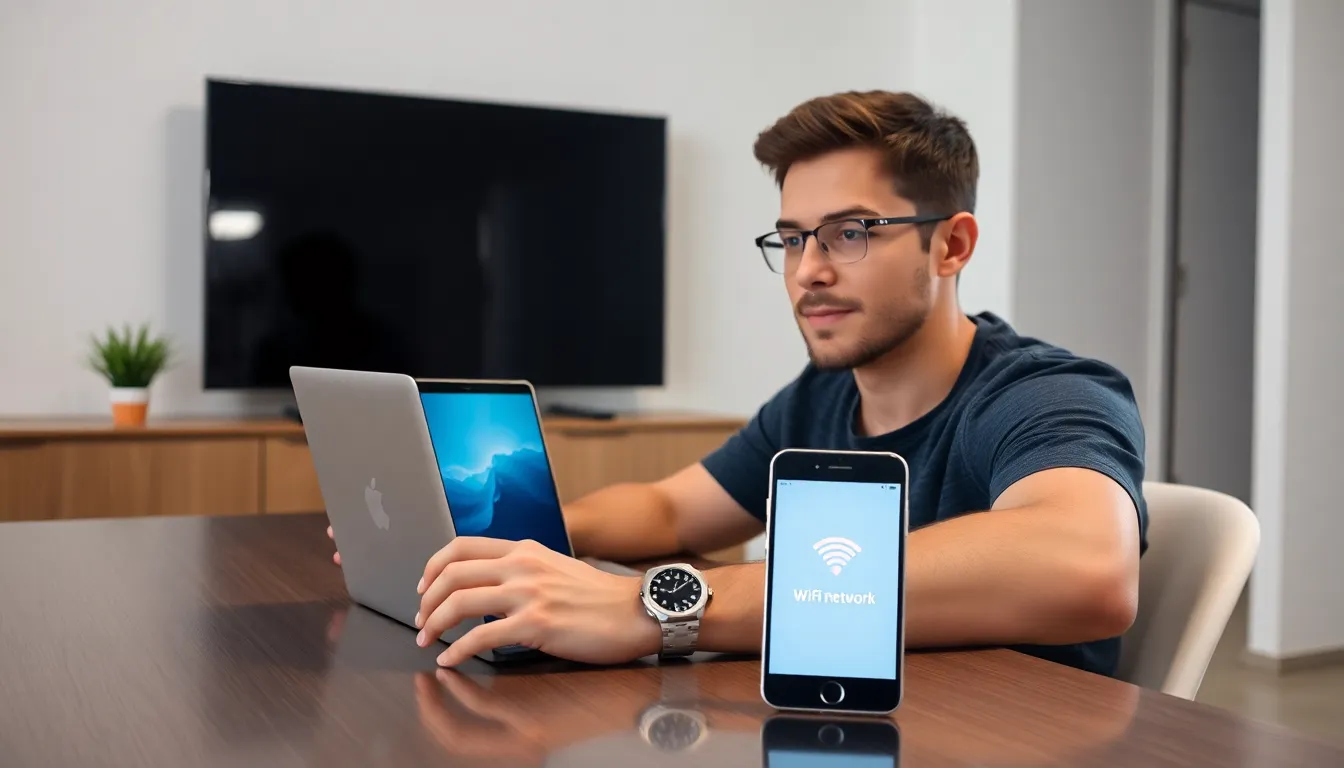Imagine this: you’re lounging on your couch, phone in hand, and suddenly you realize your iPhone’s Wi-Fi is acting like a rebellious teenager—refusing to connect to the internet. You’ve got a MacBook nearby, but typing that long, complicated Wi-Fi password feels like deciphering hieroglyphics. Fear not! Sharing your Wi-Fi password from your MacBook to your iPhone is easier than finding a cat video online.
Table of Contents
ToggleOverview of Wi-Fi Password Sharing
Wi-Fi password sharing between a MacBook and an iPhone offers a seamless connection experience. Sharing requires both devices to be within close proximity. This proximity simplifies the process, leveraging Apple’s built-in features.
Notably, the sharing feature works only if both devices are logged into separate Apple IDs. Security measures maintain user privacy, while functionality remains efficient. A significant advantage occurs when the iPhone automatically connects without manual input of the password.
The steps to share the password typically involve enabling Bluetooth and Wi-Fi on both devices. Activating Bluetooth allows them to communicate effectively. Meanwhile, ensuring that the iPhone does not have the password saved is crucial.
In this method, a prompt appears on the MacBook when the iPhone requests the password. Accepting this prompt transfers the password instantly. Users notice an increase in convenience compared to manually entering lengthy passwords.
For users unfamiliar with the process, watching a quick tutorial can be beneficial. Video guides often break down each step visually, making it easier to follow along. Regardless of their technical knowledge, most users manage to complete the sharing process without difficulty.
Ultimately, understanding the steps to facilitate Wi-Fi sharing enhances user experience across both devices. This feature reflects Apple’s commitment to creating user-friendly technology that fosters connectivity. By efficiently sharing Wi-Fi passwords, users enjoy uninterrupted internet access on their iPhones.
Requirements for Sharing

Sharing a Wi-Fi password between a MacBook and an iPhone requires specific prerequisites to ensure a smooth process. Meeting these requirements enhances connectivity.
Compatible Devices
Compatibility plays a crucial role in sharing Wi-Fi passwords seamlessly. MacBook models running macOS Sierra or later, along with iPhone models equipped with iOS 11 or newer, support this feature. Both devices must also have Bluetooth enabled. Users should ensure their devices are within close proximity, ideally within a few feet, to facilitate communication during the sharing process.
Updated Software
Keeping the software updated is essential for optimal performance. It’s important for users to install the latest macOS and iOS versions on their devices. This ensures access to the latest features and security improvements. Users can check for updates by going to System Preferences on the MacBook and Settings on the iPhone. Regular updates help maintain compatibility between the devices and support a seamless Wi-Fi password sharing experience.
Steps to Share Wi-Fi Password From MacBook to iPhone
Sharing a Wi-Fi password from a MacBook to an iPhone is straightforward, thanks to Apple’s seamless integration. The following methods simplify the process.
Using Bluetooth
Enable Bluetooth on both devices first. Proximity is crucial since the iPhone must be close. When the iPhone attempts to connect to the Wi-Fi network, a prompt appears on the MacBook screen. Accepting this prompt shares the password automatically. This process avoids the hassle of manual entry and enhances the user experience significantly.
Using iCloud Keychain
Ensure that both devices use the same Apple ID. iCloud Keychain keeps Wi-Fi passwords synced across devices. After connecting the MacBook to Wi-Fi, the password saves automatically in the Keychain. When the iPhone searches for the same network, it retrieves the stored password without user intervention. The convenience of iCloud Keychain ensures quick access, making connectivity seamless.
Troubleshooting Common Issues
Sharing a Wi-Fi password between a MacBook and an iPhone can sometimes encounter issues. Addressing these problems ensures seamless connectivity between devices.
Connection Problems
Connection troubles often stem from Bluetooth or Wi-Fi not being enabled. Both devices must have Wi-Fi and Bluetooth turned on for the password transfer to work. Proximity plays a critical role; both devices should be within a few feet of each other. If the iPhone still fails to connect, restarting both devices can resolve temporary glitches. A forgotten network issue may arise if the iPhone has previously connected to the Wi-Fi network, causing confusion in password sharing. Ensure the network is not saved on the iPhone before initiating the sharing process.
Software Compatibility
Software can significantly impact the password-sharing experience. Confirm that the MacBook runs macOS Sierra or later, while the iPhone needs iOS 11 or newer. If either device is outdated, upgrades will be necessary to utilize this feature. Compatibility allows seamless integration, enhancing user experience. In addition, ensuring that both devices are logged into separate Apple IDs is crucial; this supports privacy as well as functionality. Regularly checking for software updates helps maintain optimal performance and compatibility, ensuring a smooth connection process.
Sharing a Wi-Fi password from a MacBook to an iPhone is a quick and efficient process that enhances connectivity. By following the outlined steps and ensuring both devices are compatible, users can enjoy seamless internet access without the hassle of typing complicated passwords.
The convenience of this feature not only saves time but also showcases the user-friendly design of Apple’s ecosystem. With the right settings in place and both devices nearby, sharing becomes a straightforward task.
Embracing these modern solutions allows users to stay connected effortlessly, making technology work for them in everyday scenarios.




